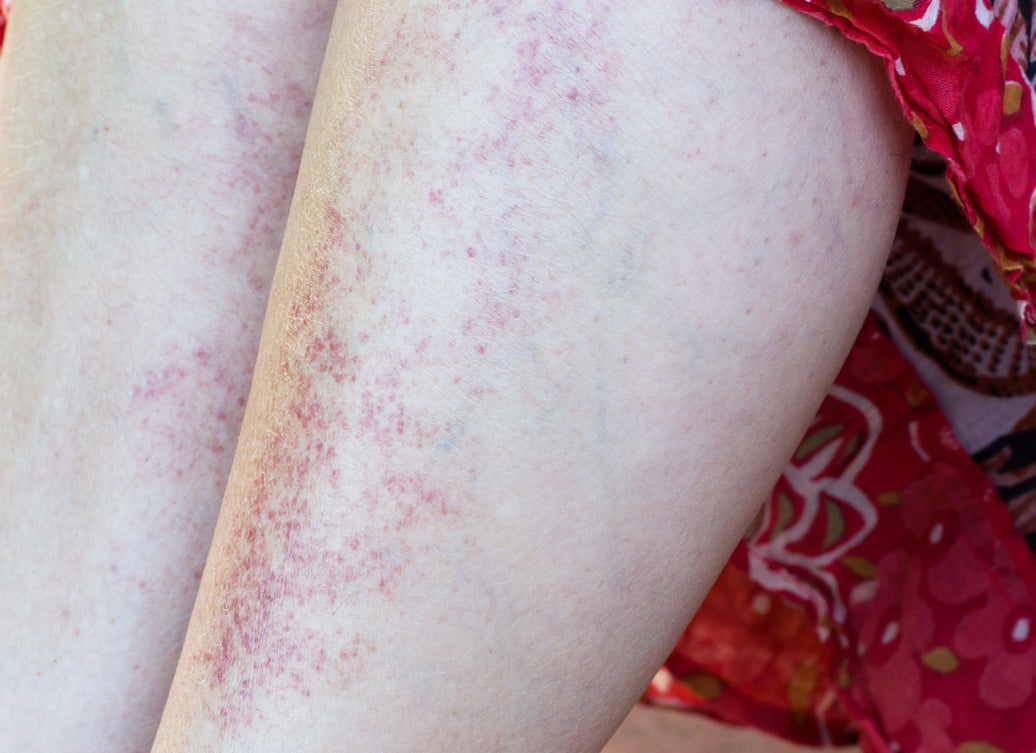Polymorphic light eruption is a complicated condition, in that it varies quite a lot from person to person. The way it looks, and the way it behaves, can be startlingly different in different sufferers, and it’s not always straightforward to diagnose PMLE rather than any other photosensitive or dry skin conditions.
What does PMLE look like?
The clue is in the name, as ‘polymorphic’ means many forms: the condition can take all kinds of different forms, and look very different in different people. But while the variety is quite large, it isn’t infinite! It’s basically irritation of the skin in different manifestations, much in the way that another skin irritation, eczema, can manifest in different ways.
It’s worth remembering that inflamed, irritated or spotty skin can look very different on skin colour, and flushes might not show up as obviously on darker skin.
Here are some of the different ways it can appear:
- Flat patches or raised plaques that can appear red on white skin, and hyper/hypopigmented on skin of colour
- Irritated dry patches or plaques, as if it were dermatitis
- Clusters of blisters which can join together into a larger inflamed area
- Pinpoint papules (small spots), which appear especially on skin of colour
- Thickened or hard areas of skin
- Occasionally manifests as target-shaped patches or bullseyes
- Patches of spots, bumps or pimples
- Sometimes there’s just itchiness, but no rashes or spots
So how can you recognise PMLE, if it tends to look like other diseases or skin conditions? Well, there are a few more characteristics to look out for that can help distinguish it from other issues!
- Affects exposed skin that has been under clothes for the rest of the year (it classically occurs on the first hot day of summer, or the first day of a sunny holiday)
- Areas likely to be affected are: the lower neck, arms, the exposed V of the upper chest, legs
- Tends not to affect the face or any parts that have been exposed to the sun all year round
- Doesn’t tend to affect the parts of the body which are under wraps, unlike heat rash or hives (although UV light can penetrate through light clothing, so PMLE sometimes happens even under clothes
- Will usually resolve if further sun exposure is avoided, or is very gradual.
For more information about polymorphic light eruption, see our article How Is Polymorphic Light Eruption Treated?
You might find Balmonds emollients useful to help keep your itchy skin in good, healthy, resilient condition. Although creams and balms cannot ‘cure’ or treat the root cause of PMLE (or other chronic skin conditions), they are effective at providing hydration, locking in moisture, smoothing thickened areas, and keeping skin soft and supple.
Our products do not contain sunscreens! Do not apply oils or oil-based balms like Skin Salvation to exposed areas of skin in bright sunlight, as the oils can make the skin more likely to burn.
Recommended products:
Balmonds Skin Salvation
with hemp and beeswax
Balmonds Daily Moisturising Cream
with shea butter and calendula
Balmonds Cooling Cream
with shea, menthol, aloe vera & lavender
